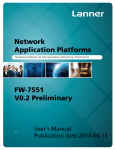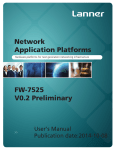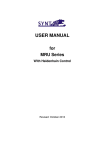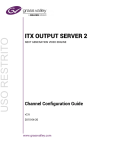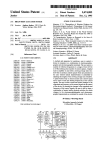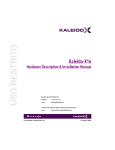Download Kaleido-MX (1RU) Quick Start Guide
Transcript
USO RESTRITO KALEIDO-MX (1RU) HIGH QUALITY, PRE-CONFIGURED MULTIVIEWER Quick Start Guide M933-9905-107 2015-04-02 USO RESTRITO Notices Copyright & Trademark Notice Copyright © 2013–2015, Grass Valley USA, LLC. All rights reserved. Belden, Belden Sending All The Right Signals, and the Belden logo are trademarks or registered trademarks of Belden Inc. or its affiliated companies in the United States and other jurisdictions. Grass Valley, Kaleido-MX, Kaleido-X, iControl, NVISION, and Densité are trademarks or registered trademarks of Grass Valley USA, LLC. Belden Inc., Grass Valley USA, LLC, and other parties may also have trademark rights in other terms used herein. Terms and Conditions Please read the following terms and conditions carefully. By using Kaleido multiviewer documentation, you agree to the following terms and conditions. Grass Valley hereby grants permission and license to owners of Kaleido multiviewers to use their product manuals for their own internal business use. Manuals for Grass Valley products may not be reproduced or transmitted in any form or by any means, electronic or mechanical, including photocopying and recording, for any purpose unless specifically authorized in writing by Grass Valley. A Grass Valley manual may have been revised to reflect changes made to the product during its manufacturing life. Thus, different versions of a manual may exist for any given product. Care should be taken to ensure that one obtains the proper manual version for a specific product serial number. Information in this document is subject to change without notice and does not represent a commitment on the part of Grass Valley. Warranty information is available in the Support section of the Grass Valley Web site (www.grassvalley.com). The SDHC Logo is a trademark of SD-3C, LLC. ii Title Kaleido-MX (1RU) Quick Start Guide Part Number M933-9905-107 Revision 2015-04-02, 19:34 USO RESTRITO Kaleido-MX (1RU) Quick Start Guide Important Safeguards and Notices This section provides important safety guidelines for operators and service personnel. Specific warnings and cautions appear throughout the manual where they apply. Please read and follow this important information, especially those instructions related to the risk of electric shock or injury to persons. Symbols and Their Meanings Indicates that dangerous high voltage is present within the equipment enclosure that may be of sufficient magnitude to constitute a risk of electric shock. Indicates that the user, operator or service technician should refer to the product manuals for important operating, maintenance, or service instructions. This is a prompt to note the fuse rating when replacing fuses. The fuse referenced in the text must be replaced with one having the ratings indicated. Identifies a protective grounding terminal which must be connected to earth ground prior to making any other equipment connections. Identifies an external protective grounding terminal which may be connected to earth ground as a supplement to an internal grounding terminal. Indicates that static sensitive components are present, which may be damaged by electrostatic discharge. Use anti-static procedures, equipment and surfaces during servicing. Indicates that the equipment has more than one power supply cord, and that all power supply cords must be disconnected before servicing to avoid electric shock. The presence of this symbol in or on Grass Valley equipment means that it has been tested and certified as complying with applicable Canadian Standard Association (CSA) regulations and recommendations for USA/Canada. The presence of this symbol in or on Grass Valley equipment means that it has been tested and certified as complying with applicable Underwriters Laboratory (UL) regulations and recommendations for USA/Canada. The presence of this symbol in or on Grass Valley equipment means that it has been tested and certified as complying with applicable Intertek Testing Services regulations and recommendations for USA/Canada. iii USO RESTRITO Notices The presence of this symbol in or on Grass Valley product means that it complies with all applicable European Union (CE) directives. The presence of this symbol in or on Grass Valley product means that it complies with safety of laser product applicable standards. Warnings • • • • • • • • • • • • • • • A warning indicates a possible hazard to personnel, which may cause injury or death. Observe the following general warnings when using or working on this equipment: Appropriately listed/certified mains supply power cords must be used for the connection of the equipment to the mains voltage at either 120 V AC or 240 V AC. This product relies on the building's installation for short-circuit (over-current) protection. Ensure that a fuse or circuit breaker for 120 V AC or 240 V AC is used on the phase conductors. Any instructions in this manual that require opening the equipment cover or enclosure are for use by qualified service personnel only. Do not operate the equipment in wet or damp conditions. This equipment is grounded through the grounding conductor of the power cords. To avoid electrical shock, plug the power cords into a properly wired receptacle before connecting the equipment inputs or outputs. Route power cords and other cables so they are not likely to be damaged. Properly support heavy cable bundles to avoid connector damage. Disconnect power before cleaning the equipment. Do not use liquid or aerosol cleaners; use only a damp cloth. Dangerous voltages may exist at several points in this equipment. To avoid injury, do not touch exposed connections and components while power is on. High leakage current may be present. Earth connection of product is essential before connecting power. Prior to servicing, remove jewelry such as rings, watches, and other metallic objects. To avoid fire hazard, use only the fuse type and rating specified in the service instructions for this product, or on the equipment. To avoid explosion, do not operate this equipment in an explosive atmosphere. Use proper lift points. Do not use door latches to lift or move equipment. Avoid mechanical hazards. Allow all rotating devices to come to a stop before servicing. Have qualified service personnel perform safety checks after any service. Cautions A caution indicates a possible hazard to equipment that could result in equipment damage. Observe the following cautions when operating or working on this equipment: • This equipment is meant to be installed in a restricted access location. iv USO RESTRITO Kaleido-MX (1RU) Quick Start Guide • When installing this equipment, do not attach the power cord to building surfaces. • Products that have no on/off switch, and use an external power supply must be installed in proximity to a main power outlet that is easily accessible. • Use the correct voltage setting. If this product lacks auto-ranging power supplies, before applying power ensure that each power supply is set to match the power source. • Provide proper ventilation. To prevent product overheating, provide equipment ventilation in accordance with the installation instructions. • Do not operate with suspected equipment failure. If you suspect product damage or equipment failure, have the equipment inspected by qualified service personnel. • To reduce the risk of electric shock, do not perform any servicing other than that contained in the operating instructions unless you are qualified to do so. Refer all servicing to qualified service personnel. Servicing should be done in a static-free environment. • This unit may have more than one power supply cord. Disconnect all power supply cords before servicing to avoid electric shock. • Follow static precautions at all times when handling this equipment. Electrostatic Discharge (ESD) Protection Electrostatic discharge occurs when electronic components are improperly handled and can result in intermittent failure or complete damage adversely affecting an electrical circuit. When you remove and replace any card from a frame always follow ESD-prevention procedures: • Ensure that the frame is electrically connected to earth ground through the power cord or any other means if available. • Wear an ESD wrist strap ensuring that it makes good skin contact. Connect the grounding clip to an unpainted surface of the chassis frame to safely ground unwanted ESD voltages. If no wrist strap is available, ground yourself by touching the unpainted metal part of the chassis. • For safety, periodically check the resistance value of the antistatic strap, which should be between 1 and 10 megohms. • When temporarily storing a card make sure it is placed in an ESD bag. • Cards in an earth grounded metal frame or casing do not require any special ESD protection. Cautions for LCD and TFT Displays Excessive usage may harm your vision. Rest for 10 minutes for every 30 minutes of usage. If the LCD or TFT glass is broken, handle glass fragments with care when disposing of them. If any fluid leaks out of a damaged glass cell, be careful not to get the liquid crystal fluid in your mouth or skin. If the liquid crystal touches your skin or clothes, wash it off immediately using soap and water. Never swallow the fluid. The toxicity is extremely low but caution should be exercised at all times. v USO RESTRITO Notices Mesures de sécurité et avis importants La présente section fournit des consignes de sécurité importantes pour les opérateurs et le personnel de service. Des avertissements ou mises en garde spécifiques figurent dans le manuel, dans les sections où ils s’appliquent. Prenez le temps de bien lire les consignes et assurez-vous de les respecter, en particulier celles qui sont destinées à prévenir les décharges électriques ou les blessures. Signification des symboles utilisés Signale la présence d’une tension élevée et dangereuse dans le boîtier de l’équipement ; cette tension peut être suffisante pour constituer un risque de décharge électrique. Avertit l'utilisateur, l’opérateur ou le technicien de maintenance que des instructions importantes relatives à l'utilisation et à l'entretien se trouvent dans la documentation accompagnant l’équipement. Invite l'utilisateur, l’opérateur ou le technicien de maintenance à prendre note du calibre du fusible lors du remplacement de ce dernier. Le fusible auquel il est fait référence dans le texte doit être remplacé par un fusible du même calibre. Identifie une borne de mise à la terre de protection. Il faut relier cette borne à la terre avant d’effectuer toute autre connexion à l’équipement. Identifie une borne de mise à la terre externe qui peut être connectée en tant que borne de mise à la terre supplémentaire. Signale la présence de composants sensibles à l’électricité statique et qui sont susceptibles d’être endommagés par une décharge électrostatique. Utilisez des procédures, des équipements et des surfaces antistatiques durant les interventions d’entretien. Le symbole ci-contre signifie que l’appareil comporte plus d’un cordon d'alimentation et qu’il faut débrancher tous les cordons d'alimentation avant toute opération d’entretien, afin de prévenir les chocs électriques. La marque C-CSA-US certifie que l’appareil visé a été testé par l'Association canadienne de normalisation (CSA) et reconnu conforme aux exigences applicables en matière de sécurité électrique en vigueur au Canada et aux ÉtatsUnis. La marque C-UL-US certifie que l’appareil visé a été testé par Underwriters Laboratory (UL) et reconnu conforme aux exigences applicables en matière de sécurité électrique en vigueur au Canada et aux États-Unis. vi USO RESTRITO Kaleido-MX (1RU) Quick Start Guide La marque ETL Listed d’Intertek pour le marché Nord-Américain certifie que l’appareil visé a été testé par Intertek et reconnu conforme aux exigences applicables en matière de sécurité électrique en vigueur au Canada et aux ÉtatsUnis. Le marquage CE indique que l’appareil visé est conforme aux exigences essentielles des directives applicables de l’Union européenne en matière de sécurité électrique, de compatibilité électromagnétique et de conformité environnementale. Le symbole ci-contre sur un appareil Grass Valley ou à l’intérieur de l’appareil indique qu’il est conforme aux normes applicables en matière de sécurité laser. Avertissements • • • • • • • • • • • • Les avertissements signalent des conditions ou des pratiques susceptibles d’occasionner des blessures graves, voire fatales. Veuillez vous familiariser avec les avertissements d’ordre général ci-dessous : Un cordon d’alimentation dûment homologué doit être utilisé pour connecter l’appareil à une tension de secteur de 120 V CA ou 240 V CA. La protection de ce produit contre les courts-circuits (surintensités) dépend de l’installation électrique du bâtiment. Assurez-vous qu'un fusible ou un disjoncteur pour 120 V CA ou 240 V CA est utilisé sur les conducteurs de phase. Dans le présent manuel, toutes les instructions qui nécessitent d’ouvrir le couvercle de l’équipement sont destinées exclusivement au personnel technique qualifié. N’utilisez pas cet appareil dans un environnement humide. Cet équipement est mis à la terre par le conducteur de mise à la terre des cordons d’alimentation. Pour éviter les chocs électriques, branchez les cordons d’alimentation sur une prise correctement câblée avant de brancher les entrées et sorties de l’équipement. Acheminez les cordons d’alimentation et autres câbles de façon à ce qu’ils ne risquent pas d’être endommagés. Supportez correctement les enroulements de câbles afin de ne pas endommager les connecteurs. Coupez l’alimentation avant de nettoyer l’équipement. Ne pas utiliser de nettoyants liquides ou en aérosol. Utilisez uniquement un chiffon humide. Des tensions dangereuses peuvent exister en plusieurs points dans cet équipement. Pour éviter toute blessure, ne touchez pas aux connexions ou aux composants exposés lorsque l’appareil est sous tension. Avant de procéder à toute opération d’entretien ou de dépannage, enlevez tous vos bijoux (notamment vos bagues, votre montre et autres objets métalliques). Pour éviter tout risque d’incendie, utilisez uniquement les fusibles du type et du calibre indiqués sur l’équipement ou dans la documentation qui l’accompagne. Ne pas utiliser cet appareil dans une atmosphère explosive. Présence possible de courants de fuite. Un raccordement à la masse est indispensable avant la mise sous tension. vii USO RESTRITO Notices • Après tout travail d’entretien ou de réparation, faites effectuer des contrôles de sécurité par le personnel technique qualifié. Mises en garde • • • • • • • • • Les mises en garde signalent des conditions ou des pratiques susceptibles d’endommager l’équipement. Veuillez vous familiariser avec les mises en garde cidessous : L’appareil est conçu pour être installé dans un endroit à accès restreint. Au moment d’installer l’équipement, ne fixez pas les cordons d’alimentation aux surfaces intérieures de l’édifice. Les produits qui n'ont pas d’interrupteur marche-arrêt et qui disposent d’une source d’alimentation externe doivent être installés à proximité d'une prise de courant facile d’accès. Si l’équipement n’est pas pourvu d’un modules d’alimentation auto-adaptables, vérifiez la configuration de chacun des modules d'alimentation avant de les mettre sous tension. Assurez une ventilation adéquate. Pour éviter toute surchauffe du produit, assurez une ventilation de l’équipement conformément aux instructions d’installation. N’utilisez pas l’équipement si vous suspectez un dysfonctionnement du produit. Faitesle inspecter par un technicien qualifié. Pour réduire le risque de choc électrique, n'effectuez pas de réparations autres que celles qui sont décrites dans le présent manuel, sauf si vous êtes qualifié pour le faire. Confiez les réparations à un technicien qualifié. La maintenance doit se réaliser dans un milieu libre d’électricité statique. L’appareil peut comporter plus d’un cordon d'alimentation. Afin de prévenir les chocs électriques, débrancher tous les cordons d'alimentation avant toute opération d’entretien. Veillez à toujours prendre les mesures de protection antistatique appropriées quand vous manipulez l’équipement. Protection contre les décharges électrostatiques (DES) Une décharge électrostatique peut se produire lorsque des composants électroniques ne sont pas manipulés de manière adéquate, ce qui peut entraîner des défaillances intermittentes ou endommager irrémédiablement un circuit électrique. Au moment de remplacer une carte dans un châssis, prenez toujours les mesures de protection antistatique appropriées : • Assurez-vous que le châssis est relié électriquement à la terre par le cordon d'alimentation ou tout autre moyen disponible. • Portez un bracelet antistatique et assurez-vous qu'il est bien en contact avec la peau. Connectez la pince de masse à une surface non peinte du châssis pour détourner à la terre toute tension électrostatique indésirable. En l’absence de bracelet antistatique, déchargez l’électricité statique de votre corps en touchant une surface métallique non peinte du châssis. viii USO RESTRITO Kaleido-MX (1RU) Quick Start Guide • Pour plus de sécurité, vérifiez périodiquement la valeur de résistance du bracelet antistatique. Elle doit se situer entre 1 et 10 mégohms. • Si vous devez mettre une carte de côté, assurez-vous de la ranger dans un sac protecteur antistatique. • Les cartes qui sont reliées à un châssis ou boîtier métallique mis à la terre ne nécessitent pas de protection antistatique spéciale. Précautions pour les écrans LCD et TFT Regarder l’écran pendant une trop longue période de temps peut nuire à votre vision. Prenez une pause de 10 minutes, après 30 minutes d’utilisation. Si l'écran LCD ou TFT est brisé, manipulez les fragments de verre avec précaution au moment de vous en débarrasser. veillez à ce que le cristal liquide n'entre pas en contact avec la peau ou la bouche. En cas de contact avec la peau ou les vêtements, laver immédiatement à l'eau savonneuse. Ne jamais ingérer le liquide. La toxicité est extrêmement faible, mais la prudence demeure de mise en tout temps. Recycling Visit www.grassvalley.com for recycling information. Certification and Compliance Safety Compliance This equipment complies with the European Directive 2006/95/EC – Low voltage directive, in addition to the following standards on safety of information technology equipment: – CAN/CSA 22.2 No. 60950-1-07, 2nd Edition, A1:2011 – UL 60950-1:2007, 2nd Edition – IEC 60950-1:2005, 2nd Edition, A1:2009 – EN 60950-1:2006, A11:2009, A1:2010, A12:2011 The power cords supplied with this equipment meet the appropriate national standards for the country of destination. ix Notices Electromagnetic Compatibility This equipment has been tested for verification of compliance with FCC Part 15, Subpart B requirements for class A digital devices. Note: This equipment has been tested and found to comply with the limits USO RESTRITO for a Class A digital device, pursuant to Part 15 of the FCC rules. These limits are designed to provide reasonable protection against harmful interference when the equipment is operated in a commercial environment. This equipment generates, uses, and can radiate radio frequency energy, and, if not installed and used in accordance with the instruction manual, may cause harmful interference to radio communications. Operation of this equipment in a residential area is likely to cause harmful interference in which case the user will be required to correct the interference at his own expense. This equipment has been tested and found to comply with the requirements of the Electromagnetic Compatibility directive 2004/108/EC: • EN 55022 Class A Radiated and conducted emissions • EN 61000-3-2 Limits for harmonic current emissions • EN 61000-3-3 Limitation of voltage fluctuations and flicker • EN 61000-4-2 Electrostatic discharge immunity • EN 61000-4-3 Radiated, radio-frequency, electromagnetic field immunity • EN 61000-4-4 Electrical fast transient immunity • EN 61000-4-5 Surge transient immunity • EN 61000-4-6 Conducted disturbances immunity • EN 61000-4-11 Voltage dips, short interruptions and voltage variations immunity x USO RESTRITO Setting Up Your Kaleido-MX Multiviewer Welcome to the Kaleido family of multiviewers! This Quick Start Guide is designed to help you get your Kaleido-MX (1RU) multiviewer up and running for the first time. The following sections will guide you through the installation of a Kaleido-MX (1RU) system in its default configuration. For more information about the Kaleido-MX (1RU) hardware, refer to the Kaleido-MX (1RU) Hardware Description & Installation Manual (on the DVD that shipped with your system). Summary Introduction . . . . . . . . . . . . . . . . . . . . . . . . . . . . . . . . . . . . . . . . . . . . . . . . . . . . . . . . . . . . . . . . . . . . . . . . . . 1 Getting Organized . . . . . . . . . . . . . . . . . . . . . . . . . . . . . . . . . . . . . . . . . . . . . . . . . . . . . . . . . . . . . . . . . . . . 3 Step 1: Physical Setup . . . . . . . . . . . . . . . . . . . . . . . . . . . . . . . . . . . . . . . . . . . . . . . . . . . . . . . . . . . . . . . . . 6 Step 2: Networking Setup . . . . . . . . . . . . . . . . . . . . . . . . . . . . . . . . . . . . . . . . . . . . . . . . . . . . . . . . . . . . . 10 Step 3: XEdit Installation . . . . . . . . . . . . . . . . . . . . . . . . . . . . . . . . . . . . . . . . . . . . . . . . . . . . . . . . . . . . . . 26 Step 4: System Verification . . . . . . . . . . . . . . . . . . . . . . . . . . . . . . . . . . . . . . . . . . . . . . . . . . . . . . . . . . . . 30 RS-422 Connection Diagram . . . . . . . . . . . . . . . . . . . . . . . . . . . . . . . . . . . . . . . . . . . . . . . . . . . . . . . . . 36 Introduction Grass Valley's Kaleido family of multiviewers ranges from quad-splits to large-scale, multiroom monitoring systems, with outstanding image quality and signal flexibility. The Kaleido multiviewers are available in different models: the Kaleido-MX, the Kaleido-IP, the Kaleido-X (7RU), the Kaleido-X (4RU), the Kaleido-X16, and the Kaleido-XQUAD frames, as well as the Kaleido-Modular-X cards, and the Kaleido-Modular KMV-3901/3911 cards. The Kaleido-MX standalone multiviewer system is ideal for production control rooms, trucks and outside broadcast operations. Available in two form factors (1 RU, and 3 RU), the Kaleido-MX supports up to 64 video inputs, and up to four multiviewer outputs. At the heart of every multiviewer system is the Kaleido-X software, which includes the following client applications: • XAdmin is a Web client that your system administrator will use to manage the multiviewer system. • XEdit is a client application used to create layouts for the monitor wall, and to configure the multiviewer, from your PC or laptop. • The Router Control Software Single Bus and Matrix View applications (also part of the iRouter Router Control Software packaged with iControl Application Servers) can be used to control your multiviewer’s logical sources and monitor wall destinations, via the KX Router logical router, or to control other logical routers configured within your multiviewer system. • Signal Path Viewer opens as a standalone panel, updated in real time, showing assignment information between router sources and multiviewer inputs. Signal Path 1 Setting Up Your Kaleido-MX Multiviewer Introduction Viewer is available for all multiviewer models, except Kaleido-IP (for which it is not relevant). A Kaleido-MX multiviewer system in its default configuration includes a number of layout presets. Each preset shows the video signals from a specific input module (card). Refer to the Kaleido-X User’s Manual (on the DVD that shipped with your multiviewer) for instructions on how to create rooms and layouts according to your specific requirements. USO RESTRITO The diagrams below show a Kaleido-MX system with its inputs and outputs. Examples of the various external devices that connect to the Kaleido-MX are also shown. A control panel would be located on the production desk, while the client PC could be anywhere with Internet access to the network. Kaleido-MX system overview 2 USO RESTRITO Kaleido-MX (1RU) Quick Start Guide Kaleido-MX functional block diagram Getting Organized This section provides information about system requirements, and items shipped with your Kaleido-MX (1RU). Required Materials Your Kaleido-MX system package includes the following: • A Kaleido-MX (1RU) unit with pre-installed cards (1 or 2 input cards, 1 or 2 output cards, a Densité CPU-ETH2 controller card, and a GPI-1501 GPI I/O module), and 1 or 2 power supplies (second power supply optional) CPU-ETH2 card Slot 1 (empty) Output card in slot 3 Input card in slot 2 Slot 4 (empty) GPI-1501 in slot 5 Example: Kaleido-MX (1RU) with one input card and one output card The table below indicates how the cards included in your Kaleido-MX (1RU) are distributed in the housing frame: Slot Card Card model 2 KMX-3901-IN-16-Q 16 × 4 Input A Applies to... KMX-3901-IN-16-D 16 × 2, 16 × 1 KMX-3901-IN-8-D Input B 8 × 2, 8 × 1 KMX-3901-IN-16-D 24 × 2, 24 × 1 3 Setting Up Your Kaleido-MX Multiviewer Getting Organized Slot Card Card model Applies to... 3 KMX-3901-OUT-D 24 × 2, 16 × 4, 16 × 2, 8 × 2 KMX-3901-OUT-S 24 × 1, 16 × 1, 8 × 1 Output B KMX-3901-OUT-D 16 × 4 Input A KMX-3901-IN-8-D 24 × 2, 24 × 1 GPI I/O GPI-1501 All 1RU configurations Output A 4 USO RESTRITO 5 • Two AC power cords • Two cable retainers • Two WECO mating connectors for each output card (for the analog audio monitoring outputs), plus one for the CPU-ETH2 controller card’s GPI output: 1RU model WECO connectors 8×1 3 8×2 3 16 × 1 3 16 × 2 3 16 × 4 1 24 × 1 3 24 × 2 3 Note: Due to space constraints at the 1RU rear panel, the 16 × 4 model does not support analog audio outputs. Audio monitoring is available at the SDI and HDMI outputs only. • Two serial port adapters (one with straight cabling and one with crossover cabling — see RS-422 Connection Diagram, on page 36): Part number Adapter cabling RS-422 pinout at the DE-9P connector 1737-3000-102 Straight Controller (SMPTE master) mode 1792-3700-100 Crossover Tributary (SMPTE slave) mode • The Kaleido-MX (1RU) Quick Start Guide (this document) 4 USO RESTRITO Kaleido-MX (1RU) Quick Start Guide • DVD including the Release Notes for the current version of the Kaleido-X software, the Kaleido-X User’s Manual, database samples, Quick Start guides and hardware reference manuals for all multiviewer models Note: In line with our commitment to environmental preservation, only the Quick Start Guide for your multiviewer model, and some ancillary documents (e.g. welcome letters, warranty cards) are distributed in printed form. All manuals and the Release Notes are available on the DVD that shipped with your multiviewer. See the Documentation section of the Release Notes for a complete list. You can obtain the latest version of the manuals, the Release Notes, as well as software and useful data, from the Software and documentation section of Grass Valley’s support portal. In addition to the above, you might need the following (not supplied): • Up to 4 displays • A dedicated 100Base-T Ethernet switch with enough ports for the Kaleido-MX, client PCs, Kaleido-RCP2, and Audio Bridge Terminals • Client PC (see below for system requirements) • Cables (to connect your multiviewer to video sources, to displays, and to the network): Cable type Purpose CAT-5 For Ethernet connectivity Display cables To connect the multiviewer’s HDMI outputs to displays: • Standard HDMI cables • Extension modules—for example, Grass Valley’s DXF-200 DVI/HDMI Optical Extension System: • part number DXF-200-C for the Kaleido-MX (1RU) 16 × 4 model only • part number DXF-200-B, for all other Kaleido-MX models To connect the multiviewer’s SDI outputs to displays: • Standard coaxial cables with DIN 1.0/2.3 connectors • SDI to HDMI 2.0 (or SDI to DisplayPort) converter—for example, AJA’s Hi5-4K Mini-Converter (firmware version 2.2 or later) Video cables Standard coaxial cables with DIN 1.0/2.3 connectors Notes • On all Kaleido multiviewers, the network adapters are set to autonegotiate. By default, the connection speed and duplex mode will be set automatically based on the corresponding port settings on the switch. • The Kaleido-MX (1RU) 16 × 4 model supports non-locking HDMI cables only. Make sure the HDMI connectors on the multiviewer side have the same dimensions. Otherwise, the built-in locking mechanism may not be able to secure the smaller connectors. You may order suitable HDMI cables from Grass Valley—HDMI to DVI female cable (1ft), part no. KXC-HDMI-DVI. 5 USO RESTRITO Setting Up Your Kaleido-MX Multiviewer Physical Setup System Requirements for a Client PC A client PC or laptop meeting the following requirements is required to access the XAdmin Web client, and the other Kaleido-X client applications. Operating system Windows XP Professional, Windows 7, Windows 8, or Windows 8.1 Processor Core 2 Duo at 2 GHz, or better Memory At least 2 GB of RAM Disk space At least 2 GB free Step 1: Physical Setup To set up the Kaleido-MX hardware 1 With the Kaleido-MX (1RU) frame (enclosure) installed in its designated rack position, and before powering up the unit, verify that each card is securely seated in its slot, and leave the frame door open so that you can monitor all the card’s LEDs. Note: For more information on the card’s LEDs, refer to the Kaleido-MX (1RU) Hardware Description & Installation Manual, available on the DVD that shipped with your system. 2 Power up the frame. Once the networking parameters are correctly configured on your Kaleido-MX output cards, it will not be necessary to switch off the housing frame’s power when installing or removing cards. The Kaleido-MX starts up. The startup sequence takes approximately four minutes, during which time every card’s status LED is blinking orange. Status LED Status LED Select button Select button Front edge of a Kaleido-MX input card 6 Front edge of a Kaleido-MX output card USO RESTRITO Kaleido-MX (1RU) Quick Start Guide Once the startup has completed, the status LEDs on the output cards should be red (steady) because the cards are not connected to the network yet. Green Normal Blinking orange Booting (or the card is selected for local control) Red Firmware initialization in progress / no Ethernet / SD card error Blinking red Fan failure / no rear / duplicate IP address 3 Connect the Kaleido-RCP2 and the Audio Bridge Terminal (if available) to a dedicated 100Base-T Ethernet switch. You can also connect a mouse and a keyboard to your Kaleido-RCP2. Notes • The Kaleido-RCP2, and Audio Bridge Terminal (ABT) are optional devices, and may not have been shipped with your Kaleido-MX system. For information on these and other Kaleido-MX options, please contact your Grass Valley sales representative. • You may need to upgrade your Audio Bridge Terminal and Kaleido-RCP2 devices (if available) to the latest firmware. The update files can be found on the DVD that shipped with your multiviewer, and on Grass Valley’s support portal. Please refer to the Kaleido-RCP2 Guide to Installation and Operation, and to the Audio Bridge Terminal Guide to Installation and Operation (available on the DVD, and from the portal) for instructions on how to determine the firmware level, and how to perform the upgrade for these devices. • The Kaleido-MX (1RU) supports one ABT device. The Kaleido-MX automatically detects the resolution of any connected display. If the required information is not available, then a fall-back resolution of 1920 × 1080 @ 60 Hz (HDTV) is used. 4 Connect outputs of the Kaleido-MX to one or more displays that support this resolution. • Monitor wall displays: Connect the multiviewer’s MV OUT outputs to the displays. • Quad-link 4K UHD output: • Four 1080p displays—In the case of a quad-head system (e.g., the 16 × 4 model) meant to output a 4K UHD signal to four 1080p displays, connect the multiviewer’s SDI monitoring outputs to the displays, referring to the table below for proper mapping. • One 4K UHD display—If your system is meant to output to a single 4K UHD display, connect the multiviewer’s SDI monitoring outputs to the display, using an SDI-to-HDMI converter, if needed. Refer to the table below for proper mapping. The SDI outputs are mapped as follows. This configuration does not support rotated displays. Refer to Creating a 4K UHD Room, and to 4K UHD Spanning, in the 7 Setting Up Your Kaleido-MX Multiviewer Physical Setup Kaleido-X User’s Manual, for instructions on how to create 4K UHD rooms and layouts. SDI OUT A1 Top left quadrant SDI OUT B1 Top right quadrant SDI OUT A2 Bottom left quadrant SDI OUT B2 Bottom right quadrant USO RESTRITO • Broadcast monitors: If your installation involves broadcast monitors, connect them to the appropriate SDI outputs. It is also possible to connect SDI outputs to a router. Refer to Configuring the HD-SDI Monitoring Output Format, in the Kaleido-X User’s Manual, for instructions on setting the scan format. If you wish to use a different resolution, see Changing the Output Resolution, on page 9, for detailed instructions. IMPORTANT Within a Kaleido-MX system, all output heads must be configured with the same refresh rate. If your system is referenced, then the heads’ refresh rate must also match the reference signal's refresh rate. 5 Connect one or more video sources to the Kaleido-MX inputs. 6 Connect a reference source (if available) to one or more reference inputs. Note: A reference is optional but, if minimal processing delay is required for your monitoring purposes, then you must reference your system. However, if you must monitor 50 Hz input signals on 60 Hz displays (or vice-versa), then do not reference your system. 7 Connect the controller card’s ETHERNET 1 port to your Ethernet switch. Note: The Kaleido-MX does not support the controller card’s second Ethernet port (ETHERNET 2). 8 Connect the output cards’ ETH ports to your Ethernet switch. IMPORTANT Make sure to connect your Densité controller and output cards to the same subnet, and that your Ethernet switch remains isolated from the rest of your network (consult your network administrator if necessary) until all required networking setup is complete. You can now proceed with the networking setup (see Step 2: Networking Setup, on page 10). 8 USO RESTRITO Kaleido-MX (1RU) Quick Start Guide Changing the Output Resolution IMPORTANT Within a Kaleido-MX system, all output heads must be configured with the same refresh rate. If your system is referenced, then the heads’ refresh rate must also match the reference signal's refresh rate. If you must monitor 50 Hz input signals on 60 Hz displays (or vice-versa), then do not reference your system. To change the display resolution from the Densité controller’s local control panel 1 Press the Select button on the front edge of the output card whose heads you wish to configure. Status LED Select button The Status LED on the selected card flashes orange, and the associated control menu appears on the LCD display of the Densité frame’s local control panel. 2 On the local control panel, press the [–] button twice, until RESOLUTION appears on the LCD display. 3 Press the SEL button. HEAD 1 appears on the LCD display. 9 USO RESTRITO Setting Up Your Kaleido-MX Multiviewer Networking Setup 4 Press the SEL button again. 5 The current resolution for the monitor wall display that is connected to the multiviewer’s output head 1 (i.e. through the MV OUT 1 connector) appears on the LCD display. 6 Press the [+] and [–] buttons, to navigate to a suitable output resolution for your monitor wall display. 7 Press SEL to apply the value shown on the LCD display. The selected resolution is applied to the multiviewer’s output head 1. 8 Press ESC to return to the previous level in the local control menu. HEAD 1 appears again on the display. 9 If you wish to change the resolution on the second output head (if available), then press the [–] button. HEAD 2 appears on the LCD display and you can repeat step 4 to step 8 above to verify or configure the resolution of the display that is connected to the multiviewer’s output head 2 (i.e. through the MV OUT 2 connector). 10 When you are satisfied with the selected output resolution settings, press the Select button on the front edge of the output card to exit the control menu. Notes • If you do not press any button on the local control panel, the Densité CPU-ETH2 controller will revert to its normal standby mode, and the selected card's status LED will revert to its normal operating mode, after 30 seconds. • If you changed a parameter from the card’s control menu, but have not applied your change (you did not press the SEL button on the local control panel), once the 30-second timeout has occurred, the parameters will be confirmed as if you had pressed the SEL button. Step 2: Networking Setup For the Kaleido-MX multiviewer to join a TCP/IP network, it must be configured with a system name, appropriate IP addresses, network mask, and gateway settings. You must also configure the Densité CPU-ETH2 controller’s networking parameters, and any Kaleido-RCP2 and Audio Bridge Terminal units you may have ordered, and a client PC to communicate with the multiviewer and its peripheral devices (see Configuring a Client PC, on page 24). A quad-head Kaleido-MX requires three IP addresses (one for each output card, one for the system), while a dual- or single-head requires only one (the output card’s IP address doubles as the system IP address). The Kaleido-MX is shipped with the following default settings: Kaleido-MX default IP settings System 10 Dual Quad IP address 192.168.3.31 192.168.3.30 Network mask 255.255.255.0 255.255.255.0 Gateway 0.0.0.0 0.0.0.0 USO RESTRITO Kaleido-MX (1RU) Quick Start Guide Kaleido-MX default IP settings (continued) Dual Quad Output A IP address 192.168.3.31 192.168.3.31 Output B 0.0.0.0 192.168.3.32 IP address Kaleido-MX housing frames are shipped with their CPU-ETH2 controller configured with the following default settings: Densité CPU-ETH2 controller default IP settings IP address 1 192.168.3.1 Network mask 255.255.255.0 Gateway 0.0.0.0 IP address 2 0.0.0.0 Network mask 0.0.0.0 Gateway 0.0.0.0 To set the system name and IP addresses for your Kaleido-MX multiviewer 1 Configure the Densité CPU-ETH2 controller with an appropriate IP address (see Setting a Densité CPU-ETH2 Controller’s IP Address, on page 12). 2 Verify that the Densité CPU-ETH2 controller’s automatic restore feature is enabled (see Enabling the CPU-ETH2 Automatic Restore Feature, on page 13). Note: For the card hot swap feature to function properly, the CPU-ETH2 automatic restore feature must be activated. 3 Configure your output cards’ networking parameters: • If you have a quad-head Kaleido-MX, replace the system IP address, network mask, default gateway, and both output cards’ IP addresses as appropriate. See Configuring the Network Settings for a Quad-Head Kaleido-MX on page 16. The system IP address will be your system’s virtual IP address. This is the address you will use to access your system from XEdit and XAdmin, for example. • If you have a single-head or a dual-head Kaleido-MX, then replace the IP address for Output A with an appropriate IP address, and change the network mask and default gateway as appropriate. See Configuring the Network Settings for a Singleor Dual-Head Kaleido-MX on page 13. The output card’s IP address will automatically become your system’s virtual IP address. 4 Configure the Kaleido-RCP2, and Audio Bridge Terminal units you have connected to your system, if any. See Using the Kaleido-RCP2 with Default Settings on page 21, and Configuring an Audio Bridge Terminal, on page 22. 5 Complete your Kaleido-MX system configuration by changing the system name, if desired. See Setting the System Name on page 18. 11 USO RESTRITO Setting Up Your Kaleido-MX Multiviewer Networking Setup Note: If there are more than one multiviewer in the same network environment, it is important to assign each a unique system name, so that you can tell them apart (for example, when using a remote control panel such as the Kaleido-RCP2 or RCP-200). You are now ready to open XAdmin and XEdit, from a client PC or laptop within the same subnet, and verify your system communication status (see Step 3: XEdit Installation, on page 26, and Step 4: System Verification, on page 30). Setting a Densité CPU-ETH2 Controller’s IP Address To set the Densité controller’s IP address 1 On the Kaleido-MX frame’s local control panel, press the CONTROLLER button. 2 Press the [–] button repeatedly until ETH1 OPTIONS appears on the display, and then press the SEL button. 3 Press the [–] button repeatedly until IP ADDRESS appears on the display. 4 Press the SEL button. The current value appears on the display. • Press the [+] and [–] buttons, to change the digit at the current input position. • Press SEL to move one position to the right. • Press ESC to move one position to the left. 5 When the display shows the desired value, press SEL repeatedly until you reach the last position (if needed), and then press SEL once more to save your changes and return to the previous menu level. Note: Pressing ESC when the input focus is in the first position returns to the previous menu level. Pressing SEL when the input focus is in the last position saves the changes and returns to the previous menu level. IP ADDRESS appears on the control panel’s display. 6 Press the [–] button. NETWORK MASK appears on the control panel’s display. 7 Repeat step 4 and step 5 to configure the netmask. 8 Once you have set the network mask, press the [–] button again. GATEWAY appears on the control panel’s display. 12 USO RESTRITO Kaleido-MX (1RU) Quick Start Guide 9 Repeat step 4 and step 5 to configure the gateway. 10 Once you have set the gateway, press the CONTROLLER button to exit the controller’s menu. The Densité controller restarts. IMPORTANT Make sure the controller’s internal clock is set to the correct date and time. The clock settings will persist for 10 days after a power loss. Should you later need to change the time on a CPU-ETH2 controller, then you will have to restart any multiviewer system housed in the same frame. Refer to the Densité CPU-ETH2 Enhanced Ethernet Controller Card Guide to Installation and Operation, for more information. Enabling the CPU-ETH2 Automatic Restore Feature To enable the CPU-ETH2 automatic restore feature 1 On the Densité frame’s local control panel, press the CONTROLLER button. 2 Press the [–] button repeatedly until RESTORE POINTS appears on the display, and then press the SEL button. 3 Press the [–] button repeatedly until DEFAULT ACTION appears on the display, and then press the SEL button. • If the control panel’s display shows UPDATE SETTINGS, then the automatic restore feature is already enabled. • If the control panel’s display shows KEEP SETTINGS, navigate to UPDATE SETTINGS by pressing the [–] button, and then press the SEL button to apply your change. 4 Press the CONTROLLER button to exit the controller’s menu. Configuring the Network Settings for a Single- or Dual-Head Kaleido-MX To configure the network settings for a Kaleido-MX with one output card 1 Press the Select button on the front edge of the output card. 13 Setting Up Your Kaleido-MX Multiviewer USO RESTRITO Networking Setup Status LED Select button The Status LED on the selected card flashes orange, and the associated control menu appears on the display of the Densité frame’s local control panel. 2 On the local control panel, press the [–] button repeatedly until NETWORK SETTINGS appears on the display, and then press the SEL button. FRAME IP ADDRESS EDIT appears on the display. 3 Press the [–] button to skip this option (the system will automatically receive the IP address you configure for Output A, once the card will have restarted). NETMASK EDIT appears on the display. 4 Press the SEL button. The current value appears on the display. • Press the [+] and [–] buttons, to change the digit at the current input position. • Press SEL to move one position to the right. • Press ESC to move one position to the left. 14 USO RESTRITO Kaleido-MX (1RU) Quick Start Guide 5 When the display shows the desired value, press SEL repeatedly until you reach the last position (if needed), and then press SEL once more to save your changes and return to the previous menu level. Note: Pressing ESC when the input focus is in the first position returns to the previous menu level. Pressing SEL when the input focus is in the last position saves the changes and returns to the previous menu level. 6 7 8 9 10 NETMASK EDIT appears on the display. Once you have set the network mask, press the [–] button. DEFAULT GW EDIT appears on the display. Repeat step 4 and step 5 to configure the gateway. Once you have configured the gateway and navigated back to the previous menu level, press the [–] button again. LINK MODE EDIT appears on the display. Press the SEL button. The current link mode appears on the display. Note: On all Kaleido multiviewers, the network adapters are set to autonegotiate. By default, the connection speed and duplex mode will be set automatically based on the corresponding port settings on the switch. 11 If your network's mode of operation requires you to change the link mode, press the [+] and [–] buttons to navigate to the suitable option (100 Mbps half-duplex, or 100Mbps full-duplex), and then press SEL to apply the value shown on the display. The selected link mode is applied. 12 Press ESC to return to the previous level in the local control menu. LINK MODE EDIT appears again on the display. 13 Press the [–] button. OUTPUT A IP EDIT appears on the display. 14 Repeat step 4 and step 5 to configure the IP address for Output A. 15 Once you have set the IP address for Output A, press the Select button on the front edge of the output card to exit the control menu. Notes • If you do not press any button on the Densité frame local control panel, the Densité controller will revert to its normal standby mode, and the selected card's Status LED will revert to its normal operating mode, after 30 seconds. • If you changed a parameter from the card’s control menu, but have not applied your change (you did not press the SEL button on the local control panel), once the 30-second timeout has occurred, the parameters will be confirmed as if you had pressed the SEL button. After a moment, the card restarts. The startup sequence takes approximately four minutes, during which time the Status LED is first red and then blinking orange. 15 USO RESTRITO Setting Up Your Kaleido-MX Multiviewer Networking Setup 16 Once the startup has completed, check the card’s Status LED again, and make sure that it does not indicate an error condition. Green Normal Blinking orange Booting (or the card is selected for local control) Red Firmware initialization in progress / no Ethernet / SD card error Blinking red Fan failure / no rear / duplicate IP address Should the Status LED indicate an error condition, refer to your Kaleido-MX (1RU) Hardware Description & Installation Manual to find out what the other LEDs might be indicating. 17 Verify that the new IP address is effective, by referring to Verifying an Output Card’s IP Address and Application Version, on page 35. Configuring the Network Settings for a Quad-Head Kaleido-MX To configure the network settings for a Kaleido-MX with two output cards 1 Press the Select button on the front edge of one of your system’s output cards. Status LED Select button The Status LED on the selected card flashes orange, and the associated control menu appears on the display of the Densité frame’s local control panel. 2 On the local control panel, press the [–] button repeatedly until NETWORK SETTINGS appears on the display, and then press the SEL button. 16 USO RESTRITO Kaleido-MX (1RU) Quick Start Guide FRAME IP ADDRESS EDIT appears on the display. 3 Press the SEL button again. The current value appears on the display. • Press the [+] and [–] buttons, to change the digit at the current input position. • Press SEL to move one position to the right. • Press ESC to move one position to the left. 4 When the display shows the desired value, press SEL repeatedly until you reach the last position (if needed), and then press SEL once more to save your changes and return to the previous menu level. Note: Pressing ESC when the input focus is in the first position returns to the previous menu level. Pressing SEL when the input focus is in the last position saves the changes and returns to the previous menu level. 5 6 7 8 9 10 11 FRAME IP ADDRESS EDIT appears on the control panel’s display. Press the [–] button. NETMASK EDIT appears on the control panel’s display. Repeat step 3 and step 4 to configure the netmask. Once you have set the network mask and navigated back to the previous menu level, press the [–] button again. DEFAULT GW EDIT appears on the control panel’s display. Repeat step 3 and step 4 to configure the gateway. Once you have configured the gateway and navigated back to the previous menu level, press the [–] button again. LINK MODE EDIT appears on the control panel’s display. Press the SEL button. The current link mode (“Auto-negotiate”) appears on the LCD display. Note: On all Kaleido multiviewers, the network adapters are set to autonegotiate. By default, the connection speed and duplex mode will be set automatically based on the corresponding port settings on the switch. 12 If your network's mode of operation requires you to change the link mode, press the [+] and [–] buttons to navigate to the suitable option (100 Mbps half-duplex, or 100Mbps full-duplex), and then press SEL to apply the value shown on the display. The selected link mode is applied. 17 Setting Up Your Kaleido-MX Multiviewer Networking Setup USO RESTRITO 13 Press ESC to return to the previous level in the local control menu. LINK MODE EDIT appears again on the LCD display. 14 Press the [–] button. OUTPUT A IP EDIT appears on the control panel’s display. 15 Repeat step 3 and step 4 to configure the IP address for Output A. 16 Once you have set the IP address for Output A, and navigated back to the previous menu level, press the [–] button again. OUTPUT B IP EDIT appears on the control panel’s display. 17 Repeat step 3 and step 4 to configure the IP address for Output B. 18 Once you have set the IP address for Output B, press the Select button on the front edge of the output card to exit the control menu. Notes • If you do not press any button on the Densité frame local control panel, the Densité controller will revert to its normal standby mode, and the selected card's Status LED will revert to its normal operating mode, after 30 seconds. • If you changed a parameter from the card’s control menu, but have not applied your change (you did not press the SEL button on the local control panel), once the 30-second timeout has occurred, the parameters will be confirmed as if you had pressed the SEL button. After a moment, both output cards restart. The startup sequence takes approximately four minutes, during which time the cards’ Status LEDs are first red and then blinking orange. 19 Once the startup has completed, check both cards’ Status LEDs again, and make sure that they do not indicate an error condition. Green Normal Blinking orange Booting (or the card is selected for local control) Red Firmware initialization in progress / no Ethernet / SD card error Blinking red Fan failure / no rear / duplicate IP address Should a Status LED indicate an error condition, refer to your Kaleido-MX (1RU) Hardware Description & Installation Manual to find out what the other LEDs might be indicating. 20 Verify that both cards’ and the system’s new IP addresses are effective, by referring to Verifying the Multiviewer’s IP Addresses and Application Version, on page 34. Setting the System Name Once you have configured the output cards from the local control panel, use XAdmin to complete your system’s network setup. 18 USO RESTRITO Kaleido-MX (1RU) Quick Start Guide To set your Kaleido-MX system name 1 Configure your client PC or laptop with an IP address in the same range as the multiviewer’s current IP addresses if needed (see Configuring a Client PC, on page 24). 2 Open a Web browser window and enter the multiviewer’s system IP address in the address bar (see Finding the System IP Address, on page 34, if needed). 3 The Kaleido-X home page appears. 4 Click the XAdmin button. 5 If you see a security warning, or a certificate error message, then refer to Registering your Multiviewer's Security Credentials with your Browser, in the Kaleido-X User’s Manual. 6 If the “Log in to XAdmin” page appears, type the password, and then click Log in. 7 Internet Explorer users: If a blank page appears, then refer to Enabling the Compatibility View in Internet Explorer 10, in the Kaleido-X User’s Manual. The XAdmin Status and Options page appears. 8 Click System configuration, in the navigation area on the left of the page. The System Configuration page appears, showing the current system name, IP addresses, network mask, default gateway, connection-speed and duplex-mode 19 Setting Up Your Kaleido-MX Multiviewer Networking Setup USO RESTRITO settings, information about your housing frame, the input cards and the output card you are currently connected to, as well as date and time settings. 9 Under General, type the name you wish to use for your system. If there are more than one multiviewer in the same network environment, it is important to assign each a unique system name, so that you can tell them apart (for example, when using a remote control panel such as the Kaleido-RCP2 or RCP-200). Only lower-ASCII characters are allowed in the system name. Braces and tilde are not allowed. Note: Under Ethernet, you may review the IP addresses, network mask, gateway settings, and the detected connection speeds and duplex modes. Should you wish to make any further changes to the network settings, you may find it more convenient to use XAdmin’s System configuration page, from now on. 10 Click Save. The new settings are saved locally, and XAdmin reminds you to click Apply Setting before closing your session. 20 USO RESTRITO Kaleido-MX (1RU) Quick Start Guide 11 Click OK. The Apply settings button becomes available. 12 Click Apply settings. The multiviewer must restart for changes to the network configuration to take effect. A message appears prompting you to restart the system immediately. 13 Click OK. Note: Settings cannot be applied to a multiviewer system while an upgrade is in progress. If the multiviewer does not restart after 10 seconds or so, try clicking Apply settings again after a minute or two. Using the Kaleido-RCP2 with Default Settings Note: The Kaleido-RCP2 unit is optional and is not included in the standard Kaleido-MX package. To start using the Kaleido-RCP2 with its default settings 1 Physically connect the Kaleido-RCP2 unit to the network using an Ethernet cable. By default, the Kaleido-RCP2 is configured with DHCP enabled, so it will automatically be assigned an IP address by a DHCP server. If no DHCP server can be found, the Kaleido-RCP2 will fall back to its default static IP address, subnet mask, and gateway settings: Default IP address 10.0.3.191 Default subnet mask 255.255.0.0 Default gateway 0.0.0.0 Notes • If you need to operate with a fixed IP address, you must use the Configuration menu to disable DHCP and set up the correct IP address, Network Mask, and Gateway (see Enabling or Disabling DHCP, and Setting an IP Address, Subnet Mask and Gateway, in the Kaleido-RCP2 Guide to Installation and Operation, available on the DVD that shipped with your system.) 21 Setting Up Your Kaleido-MX Multiviewer Networking Setup Notes (continued) • To access rooms located in other subnets, the Kaleido-RCP2 must be configured with the appropriate unicast IP addresses (see Configuring Unicast IP Addresses, in the Kaleido-RCP2 Guide to Installation and Operation, available on the DVD that shipped with your system.) USO RESTRITO 2 On the Kaleido-RCP2 unit, press the ENTER button and hold it until the ESC button lights up. The following message appears on the LCD display: Configuration ROOM SELECTION 3 Press ENTER again to obtain the room list from the multiviewers that are currently available on the network. The message ROOM Select followed by the name of the first room available appears on the LCD display. 4 Press the 2 key (to move up in the list) or the 8 key (to move down the list) until Room1 is displayed. 5 Press ENTER, and then press ESC to exit the configuration menu. 6 Press the LOGIN button. The following message appears on the LCD display: LOGIN Position Admin 7 Press ENTER to log on to your system as “Admin”. A message prompting you for a password appears on the LCD display. 8 Press ENTER again (by default, there is no password). The message “Access granted” will appear on the LCD display if the login is successful. If a mouse is connected to the Kaleido-RCP2, then you should be able to see and move the mouse pointer on the monitor wall. 9 Press any of the LAYOUT PRESETS buttons to load a predefined layout on the monitor wall. If your system was configured prior to shipment, then a layout will appear on all displays. Otherwise, a gray screen will appear with the following message in the middle: “No layout has been assigned to this room. Please load a layout.” Note: To access other layouts, press the LOAD button. To assign a layout to a preset button, press and hold the button for more than six seconds while the desired layout is showing on the monitor wall. Configuring an Audio Bridge Terminal The optional Audio Bridge Terminal (ABT) is an external audio multiplexer/serializer for the Kaleido-MX. The Kaleido-MX supports audio channel inputs from the ABT-64 or ABT-128 22 USO RESTRITO Kaleido-MX (1RU) Quick Start Guide series of Audio Bridge Terminal panels through SDTI inputs. The ABT-64 supports 64 channels and the ABT-128 supports 128 channels. There is not enough space on the Kaleido-MX rear panels to also include discrete audio connectors. An ABT provides connector space for multiple audio signal inputs, and multiplexes all the audio signals into combined serial feeds on coaxial cables that connect to Kaleido-MX input cards. Note: The ABT is powered through the RJ-45 Ethernet connector. There is no power ON/OFF button, so the device is ON whenever a powered Ethernet cable (PoE) is connected. To configure the IP address and other network settings of the ABT 1 Connect a PC to a switch. 2 Referring to Configuring a Client PC, on page 24, configure the PC with the following network settings: DHCP OFF Static IP address 10.0.0.1 Subnet mask 255.255.0.0 Default gateway 10.0.0.1 3 Apply power to the Audio Bridge Terminal and make sure it is connected to the same switch as the PC. • If the switch is Power over Ethernet (PoE) enabled, simply connect it to the unit using an Ethernet cable. • If not, PoE mid-span (inserter) equipment must be placed between the switch and the Audio Bridge Terminal. 4 Press the RESET button (located on the right-hand side of the ABT rear panel beside the ETHERNET/POWER RJ-45 connector) for at least 1 second. The Audio Bridge Terminal will reboot with the following static network configuration: DHCP OFF Static IP address 10.0.3.190 23 USO RESTRITO Setting Up Your Kaleido-MX Multiviewer Networking Setup Subnet mask 255.255.0.0 Default gateway 10.0.0.1 5 Using a Web browser on the PC, connect to the ABT using the following address: 10.0.3.190. The home page of the ABT’s built-in Web server is displayed. 6 Click Network Configuration (in the navigation pane). The Network Configuration page is displayed. 7 Change the ABT’s network settings, as necessary, and then click Apply & Reboot. Notes • The Kaleido-MX (1RU) supports one ABT device. • Keep in mind that all ABTs ship with the same default static IP address. If you are adding more than one ABT to your network and do not use DHCP, make sure to assign each ABT a different static IP address before connecting them to the network. For more information about the ABT, refer to the Audio Bridge Terminal Guide to Installation and Operation, available on the DVD that shipped with your system. Configuring a Client PC The client PC that you will use to communicate with the Kaleido-MX multiviewer (via XAdmin and XEdit), and the multiviewer itself, must have IP addresses within the same subnet. The following procedure applies to a typical Windows 7 or Windows 8 system. For Windows XP, see Changing an IP Address on Windows XP, on page 26. Changing an IP Address on Windows 7 or Windows 8 To change the IP address of a client PC that has Windows 7 or Windows 8 1 Press the Windows key on your keyboard, type “control panel” and then press Enter. 2 In the search box, type “adapter”, and then, under Network and Sharing Center, click View network connections. 3 In Network Connections, right-click the network adapter you wish to configure (e.g., Local Area Connection, or Ethernet), and then click Properties. If the system prompts you 24 USO RESTRITO Kaleido-MX (1RU) Quick Start Guide for an administrator password or confirmation, type the password or provide confirmation. The Properties window for the selected network adapter opens. 4 On the Networking tab, under This connection uses the following items, click Internet Protocol Version 4 (TCP/IPv4), and then click Properties. The Internet Protocol Version 4 (TCP/IPv4) Properties window opens. 5 On the General tab, click Use the following IP address. 6 Type an IP address in the same range as the multiviewer’s current IP address. For example, if the multiviewer’s IP address is 192.168.3.31, then the IP address of your client PC could be 192.168.3.123. If you are unsure, contact your network administrator. 7 Type a subnet mask in the same range as that of the multiviewer. 25 USO RESTRITO Setting Up Your Kaleido-MX Multiviewer XEdit Installation 8 Click OK. 9 In Local Area Connection Properties, click Close. Changing an IP Address on Windows XP To change the IP address of a client PC that has Windows XP 1 On the Start menu, point to Control Panel, right-click Network Connections, and then click Open on the menu. 2 In Network Connections, right-click Local Area Connection, and then click Properties on the shortcut menu. 3 In Local Area connection Properties, select Internet Protocol (TCP/IP) from the list on the General tab, and then click Properties. The Internet Protocol (TCP/IP) Properties window opens. 4 On the General tab, click Use the following IP address. 5 Type an IP address in the same range as the multiviewer’s current IP address. For example, if the multiviewer’s IP address is 10.0.3.70, then the IP address of your client PC could be 10.0.3.123. If you are unsure, contact your network administrator. 6 Type a subnet mask in the same range as that of the multiviewer. 7 Click OK. 8 In Local Area Connection Properties, click Close. Step 3: XEdit Installation XEdit is a client application used to create layouts for the monitor wall, and to configure your multiviewer system, from your PC or laptop. When the computer with XEdit is connected to the multiviewer through a TCP/IP network, you can use XEdit to modify layouts and settings directly on the multiviewer, or you can work locally on the computer and then export your changes to the multiviewer. To install XEdit from your multiviewer’s home page 1 From a workstation on the same subnet as the multiviewer, open a Web browser window and type the multiviewer’s IP address in the address bar. The multiviewer’s home page appears. 26 USO RESTRITO Kaleido-MX (1RU) Quick Start Guide 2 Click the XEdit button. The browser prompts you to save an executable file to your hard drive (Kaleidowindows32-online.exe1). This file is an online installer, which will download XEdit and other companion elements from your multiviewer, and install them. Some browsers may allow you to run the file directly. Depending on your browser’s security features, warnings may appear, which you may safely dismiss. 3 Unless your browser let you run the file (and you chose to do so), navigate to the location were you saved the installer file and open it. More security warnings or prompts may appear, which you may safely dismiss or accept. A window appears, showing the download and installation progress. At the end of the installation process: • If you have Windows 7, or Windows XP, shortcuts ( and to the Start menu (under All Programs). ) are added to your desktop 1.Installers for Linux or Mac OS X are not yet available. 27 Setting Up Your Kaleido-MX Multiviewer XEdit Installation USO RESTRITO • If you have Windows 8.1, or Windows 8, XEdit will appear on your desktop, in the Apps view with all the other applications on your PC (Windows 8.1), or in your Start screen (Windows 8). Once the installation has completed, the XEdit startup screen appears. Depending on your Windows Firewall settings, a security alert may appear. • Click Allow access to unblock the application. If XEdit cannot find all of the fonts it needs already on your PC or laptop, it downloads them from the multiviewer automatically, in which case a message will appear to confirm the font update, and instruct you to restart the application. 28 USO RESTRITO Kaleido-MX (1RU) Quick Start Guide • Click OK to continue, and then open XEdit again, by using the shortcut on your desktop, in your Apps view (Windows 8.1) or Start screen (Windows 8), or from the Start menu (Windows 7, Windows XP). 4 When prompted to specify a database, choose one from the Path list, or click Browse to navigate to the database you wish to use as your local workspace, and then click OK. Once the database has completed loading, XEdit’s main application window appears. Note: Once it has been installed from the multiviewer, XEdit remains on your PC or laptop, and can be launched from the shortcut that was added to your desktop, Apps view, or Start screen (see page 27), or from the Start menu. Whenever you install a new version of the Kaleido-X software on the multiviewer, the next time you open XEdit, your installed copy of the application will be automatically updated from the multiviewer. For more information about calibrating your system, configuring rooms, creating layouts, and operating the monitor wall, refer to the Kaleido-X User’s Manual, available on the DVD that shipped with your system, and from Grass Valley’s support portal. 29 Setting Up Your Kaleido-MX Multiviewer System Verification Step 4: System Verification Verifying the Kaleido-MX Multiviewer Status You can check internal system statuses via the Web-based XAdmin application. USO RESTRITO To verify the status of your Kaleido-MX multiviewer 1 Open a Web browser window and enter your multiviewer’s system IP address (the IP address you configured for Output A, in the case of a single- or dual-head system (see step 14 on page 15), or the virtual IP address you configured at step 4 on page 17, in the case of a quad-head system) in the address bar. The Kaleido-X home page appears. 2 Click the XAdmin button. 3 If you see a security warning, or a certificate error message, then refer to Registering your Multiviewer's Security Credentials with your Browser, in the Kaleido-X User’s Manual. 4 If the “Log in to XAdmin” page appears, type the password, and then click Log in. 5 Internet Explorer users: If a blank page appears, then refer to Enabling the Compatibility View in Internet Explorer 10, in the Kaleido-X User’s Manual. The XAdmin Status and Options page appears, displaying a list of all modules and their statuses. 30 USO RESTRITO Kaleido-MX (1RU) Quick Start Guide 6 Click Physical connections, in the navigation area on the left of the page. The Physical Connections page appears, showing the current connection status for your system, with a visual representation of the physical connections between the detected input cards and the output cards associated with the frame IP address. 31 Setting Up Your Kaleido-MX Multiviewer USO RESTRITO System Verification 7 Review the information on this page, to make sure your input and output cards are all properly interconnected. Information in red indicates the location where a problem was detected. 8 Click Status and options, in the navigation area on the left of the page, to go back to the Status and Options page. The module headings show the card type and serial number for the input and output cards, and a summary view of the input signals for each input card. 9 Move the pointer to an input signal status icon to view the associated signal format. 32 USO RESTRITO Kaleido-MX (1RU) Quick Start Guide Card type Serial number Input signal status Input signal format 10 Click the arrow button ( ) at the end of a module’s heading row to view detailed information. Reset card Expand details Refresh 11 Review the enabled input and output options, and the main system statuses of the Kaleido-MX frame, to make sure that there are no status errors, and no alerts related to system temperature, fan operation, FlexBridge connectivity, or card fault conditions. Notes • At any time you can click the Refresh button to make sure the data displayed for the selected card is up to date. Click the Reset card button at the end of a card’s heading row to reset the card remotely, directly from your Web browser. • See Managing Hardware and Software Options, in the Kaleido-X User’s Manual, for more information on the available options. Verifying the Kaleido-RCP2 To verify that the Kaleido-RCP2 is functioning normally • Log on to the Kaleido-RCP2 (see Using the Kaleido-RCP2 with Default Settings, on page 21), and then test various operations using the Kaleido-RCP2 keyboard and the mouse (e.g. load a predefined layout). Loading a Layout To load a layout on the monitor wall 1 Connect a mouse to the Kaleido-RCP2 (if available) and log on to the appropriate room, if you have not already done so (see Using the Kaleido-RCP2 with Default Settings, on page 21). 33 USO RESTRITO Setting Up Your Kaleido-MX Multiviewer System Verification Alternatively, connect the mouse directly to the USB port at the front of one of your system’s output card. 2 Right-click anywhere on the monitor wall, point to Monitor wall (if you clicked a monitor), and then click Load layout on the menu. Monitor wall menu A layout browser appears on the displays associated with the current room. 3 Select the layout you wish to load from the list of available layouts for this room, and then click OK. The selected layout appears on the room displays. Verifying the Audio Bridge Terminal To verify that the ABT is functioning normally • Inspect the ACTIVITY and front panel LEDs on the unit to make sure there are no error conditions: The ACTIVITY indicator is located on the right-hand side of the rear panel. This LED reports the status of the Ethernet connection as indicated in the table below. Two LEDs are visible on the front panel, one for each power supply. When lit, they both indicate the same status. When the ABT is powered up, all three LEDs will be orange until the boot sequence is terminated. This is a visual indicator that the LEDs are functioning properly. ACTIVITY Indicator on Rear Panel Power-Supply LEDs on Front Panel Color Status Color Status Off No link detected Green Normal Green Normal (good link) Flashing green Normal, rebooting Orange Activity Orange Warning Red Hardware fault Flashing orange Warning, rebooting Flashing red Upgrading firmware Red Hardware fault Flashing red Upgrading firmware Verifying the Multiviewer’s IP Addresses and Application Version Finding the System IP Address To find your multiviewer’s system IP address 1 Press the Select button on the front edge of a Kaleido-MX output card. 34 USO RESTRITO Kaleido-MX (1RU) Quick Start Guide The Status LED on the selected card flashes orange, and the associated control menu appears on the display of the Densité frame’s local control panel. 2 On the local control panel, press the [–] button repeatedly until NETWORK SETTINGS appears on the display, and then press the SEL button. FRAME IP ADDRESS EDIT appears on the control panel’s display. 3 Press the SEL button again. The current system IP address appears on the display. This is your system’s virtual IP address (i.e., the address you will use to access your system from XEdit and XAdmin). 4 Press the Select button on the front edge of the output card to exit the control menu. Verifying an Output Card’s IP Address and Application Version To verify the IP address and application version on an output card 1 Press the Select button on the front edge of the Kaleido-MX output card. The Status LED on the selected card flashes orange, and the associated control menu appears on the display of the Densité frame’s local control panel. 2 Note the position indication A or B in the card information shown on the first line of the LCD display: either KMX-OUTA, or KMX-OUTB, followed with the slot number (e.g., KMXOUTA Slot 4). 3 On the local control panel, press the [–] button. The version of the Kaleido-X Software that is running on the card (e.g. “7.33build.5516”) appears on the display. 4 On the local control panel, press the [–] button repeatedly until NETWORK SETTINGS appears on the display, and then press the SEL button. FRAME IP ADDRESS EDIT appears on the control panel’s display. 5 If the card is identified as KMX-OUTA on the display, then press the [–] button repeatedly until OUTPUT A IP EDIT appears. If the card is identified as KMX-OUTB, then press the [–] button until OUTPUT B IP EDIT appears. 6 Press the SEL button. The current IP address for this card appears on the display. Note: If you have a single- or dual-head Kaleido-MX multiviewer, then this IP address doubles as the system IP address. 7 Press the Select button on the front edge of the output card to exit the control menu. 35 USO RESTRITO Setting Up Your Kaleido-MX Multiviewer RS-422 Connection Diagram Verifying an Input Card’s Application Version To verify the application version on an input card 1 Press the Select button on the front edge of the Kaleido-MX input card. Status LED Select button The Status LED on the selected card flashes orange, and the associated control menu appears on the display of the Densité frame’s local control panel. 2 On the local control panel, press the [–] button. The version of the Kaleido-X Software that is running on the card (e.g. “7.33build.5516”) appears on the display. 3 Press the Select button on the front edge of the input card to exit the control menu. RS-422 Connection Diagram Each output card supports one RS-422 serial port over an RJ-45 connector. This port allows the Kaleido-MX to connect to external serial devices such as a router, production switcher, or router controller. Note: The RS-422 ports each have an RJ-45 connector in order to preserve space on a busy panel. The RS-422 interface specifies a DE-9 connector, so if you are using this interface, you will require a DE-9-to-RJ-45 adapter. Grass Valley supplies two adapter models, correctly wired for this application: a straight adapter (part no. 1737-3000-102), and a crossover adapter (part no. 1792-3700-100). The pinout for the RS-422 signals on the RJ-45 connectors, and the wiring diagrams for the appropriate adapters, are shown here: 36 USO RESTRITO Kaleido-MX (1RU) Quick Start Guide Pinout of each RS-422 port’s RJ-45 connector on the multiviewer RJ-45 DE-9 male DE-9 female Pinout of straight adapter (Grass Pinout of RS-422 Valley part no. 1737-3000-102) connector on SMPTE slave device Standard wiring between multiviewer and devices wired to SMPTE “slave” specification (e.g. most routers, Ross Synergy switchers, Nevion ETH-CON) Pinout of each RS-422 port’s RJ-45 connector on the multiviewer RJ-45 DE-9 male DE-9 female Pinout of crossover adapter (Grass Pinout of RS-422 Valley part no. 1792-3700-100) connector on SMPTE master device Standard wiring between multiviewer and devices wired to SMPTE “master” specification (e.g. Philips Jupiter router control system, Grass Valley Presmaster PCS) Note: The two RS-422 ports on the multiviewer side have no ground pin. Using the appropriate DE-9S-to-RJ-45 adapter, an external device should be able to communicate with a multiviewer despite the lack of a ground. For more information about the RS-422 specifications, see the “Communication” section in the Specifications chapter of the Kaleido-MX (1RU) Hardware Description & Installation Manual. For more information about the RS-422 serial connections, see the “Serial Connections” section in the Routers chapter of the Kaleido-X User’s Manual. 37 USO RESTRITO USO RESTRITO Contact Us Grass Valley Technical Support For technical assistance, contact our international support center, at 1-800-547-8949 (US and Canada) or +1 514 333 1772. To obtain a local phone number for the support center nearest you, please consult the Contact Us section of Grass Valley’s Web site (www.grassvalley.com). An online form for e-mail contact is also available from the Web site. Corporate Head Office Grass Valley 3499 Douglas-B.-Floreani St-Laurent, Quebec H4S 2C6 Canada Telephone: +1 514 333 1772 Fax: +1 514 333 9828 www.grassvalley.com





















































